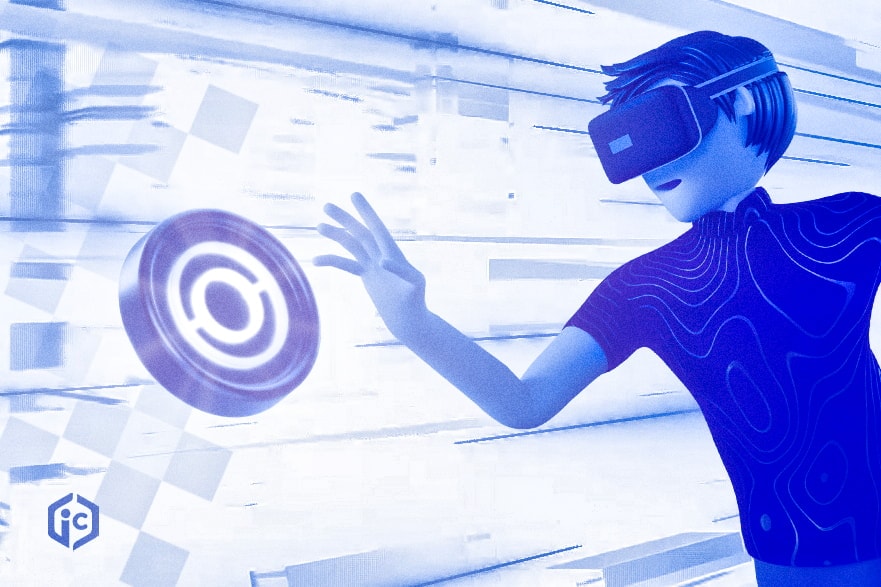The notion of a «metaverse» has become an increasingly palpable reality, becoming more than just a fad to become a technological trend for the coming years. This concept conjures up images of immersive digital worlds where people can interact, work, play and live. However, the key question is: how do we build these digital worlds and what role does CUDOS blockchain technology play in this exciting development?
The Metaverse and the Promise of Decentralization
The metaverse is a term that has become popular thanks to disruptive technology companies and their vision of a digital world that transcends the borders of virtual reality or augmented reality. More recently, Apple announced the launch of “Vision Pro”, a mixed reality device designed to interact virtually in an immersive way.
In essence, the metaverse is about creating a digital universe where individuals can explore, interact or trade. CUDOS could play a crucial role in building these immersive digital worlds thanks to its technology, and decentralization is one of its most notable advantages.
Decentralization: A Pillar of the Metaverse
Decentralization is a fundamental principle of CUDOS blockchain technology. Unlike centralized systems, where one entity has absolute control, decentralization means that power and decision-making are distributed across a network of independent nodes.
This has a significant impact on building immersive realities like the metaverse:
- Autonomy and ownership: in a decentralized metaverse built on the CUDOS blockchain network, users would have greater control over their data and digital assets. They would not be subject to the restrictions imposed by a single centralized entity. This means that digital items, from virtual goods to digital identities, truly belong to users, encouraging autonomy and ownership. Users can own digital assets, such as virtual lands, collectibles, or even avatars, and transfer them without the need for intermediaries.
- Interoperability: decentralization allows interoperability between different metaverses and applications. Immersive digital worlds built on blockchain can communicate and share assets and protocols, creating an expansive and diversified ecosystem. This expands the possibilities of economic experiences and opportunities. In the future, perhaps users will be able to carry their digital assets from one metaverse to another, promoting fluidity and richness of experiences.
- Community governance: decision making in a decentralized metaverse is typically in the hands of the user community. Updates are often put to a vote, ensuring greater transparency and participation in the development of the metaverse. Decentralization allows users to influence the future direction of the metaverse, which is critical to ensuring it aligns with the needs and desires of the community.
- Security and trust: the blockchain technology present in CUDOS provides a high level of security and trust. Immutable ledgers and robust cryptography could protect digital assets and transactions in the metaverse, lowering the risks of fraud and cyberattacks. Security is especially crucial in a digital environment where users store valuable assets.
- Decentralized economy: decentralization not only affects governance, but also the economy. Blockchain-based metaverses often have their own currencies and decentralized economic systems. This can open up new income opportunities for users through the creation and marketing of digital content. Users could earn income by selling virtual properties, creating engaging content, offering services within the metaverse, and more.
The Future of the Decentralized Metaverse
As we move towards a decentralized metaverse, collaboration between companies, developers and communities will be essential. Decentralization encourages innovation, diversity and equal opportunities, which is essential to building an inclusive and sustainable metaverse. The interconnection of metaverses will allow users to carry their identities and assets from one virtual world to another, driving adoption and growth in this exciting space.
On this path, CUDOS technology will play a fundamental role, and the future will surely bring great news ahead.
Conclusion
Building immersive digital worlds like the metaverse using CUDOS blockchain technology offers numerous advantages, with decentralization as one of its fundamental pillars. This would enable user ownership and autonomy, interoperability, community governance, security, and a decentralized economy.
As we explore the possibilities of the metaverse, it is clear that decentralization will play a crucial role in creating a more open, equitable and exciting digital future. We are on the threshold of a new digital era where community and technology come together to build immersive worlds that challenge the limits of imagination.
About CUDOS
Cudos is a layer 1 blockchain and layer 2 community-governed distributed cloud computing network.
Its Infrastructure as a Service (IAAS) approach ensures users have decentralized, permissionless access to high-performance cloud computing at scale.
For more information, visit the official CUDOS website and social media:
Website – Twitter – Telegram – YouTube – Discord – Medium – Podcast
This article was originally written by CUDOS UNO, published at https://www.cudos.uno/ and translated by CUDOS UNO.
Original article: Construyendo Mundos Digitales Inmersivos con CUDOS

